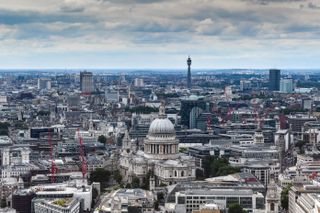Why you can trust TechRadar
Performance
- 8fps burst shooting
- 180K-pixel metering sensor
- 950-shot battery life
With a raft of mirrorless cameras, such as the Fujifilm X-T3, overshadowing the 6fps burst shooting performance of the now discontinued D7200, it was no surprise to see the Nikon D7500 offering 8fps.
Helped by the new EXPEED 5 image processor, the D7500 can shoot a burst of 50 raw files before the buffer needs to clear – quite an improvement over the D7200’s 18 raw files at 6fps, and impressive for a non-professional DSLR.

As we've touched upon, the D7500 inherited the D5 and D500’s 180,000-pixel RGB sensor, which handles metering and white balance, as well as informing the automatic scene recognition system to help improve autofocusing with better subject detection.
As expected the metering system performs very well, consistently delivering spot-on exposures, while the Auto White Balance does a solid job too.
There's a new battery as well – the EN-EL15a is good for 950 shots before it needs charging. That's still streets ahead of most mirrorless cameras, for which you'd need two or more batteries to even think of getting that kind of endurance, but it's actually down 150 shots from the D7200's 1,100-shot battery life – undoubtably one of the trade-offs for having the more powerful EXPEED 5 image processor on board here.
Image quality
- ISO100-51,200, expandable to 50-1,640,000
- Impressive dynamic range
- Excellent noise performance
With the same sensor as the fabulous D500 at the heart of things, the results from the Nikon D7500 are predictably excellent.
It may have slightly less pixels than more affordable DX Nikon DSLRs, but unless you're going to spend most of your time shooting at ISO 100, the minor drop in resolution is a compromise worth making.

This is underlined when you look at images through the ISO range. Shots taken at the lower end of the sensitivity range display excellent levels of detail, but the camera really starts to shine as you bump up the ISO setting.
While detail does suffer a touch at ISO 6400, results stand up remarkably well. Increase the sensitivity a further stop to ISO 12,800, and while there's now a hint of chroma (color) noise in shots, results are still very good.

Click here to see the full-size image

Click here to see the full-size image

Click here to see the full-size image

Click here to see the full-size image

Click here to see the full-size image
As you'd expect, luminance (grain-like) noise becomes more pronounced at ISO25,600 and ISO51,200, but the results are still some of the best we've seen from a camera at these sensitivities.
Once you go beyond the realm of the camera's native sensitivities, things do tail off. That said, results at Hi1 (ISO 102,400) are actually pretty good for such a high value, but banding starts to creep into images shot at Hi2 (ISO 204,800); we'd caution against using anything higher, as results can look pretty murky and suffer from a severe lack of detail.
Dynamic range is also very impressive. It's possible to recover shadow detail in a shot that's been underexposed by some five stops – even six at a push – and still end up with a very satisfactory shot.
Current page: Performance and image quality
Prev Page Build, handling and AF Next Page Verdict and competitionPhil Hall is an experienced writer and editor having worked on some of the largest photography magazines in the UK, and now edit the photography channel of TechRadar, the UK's biggest tech website and one of the largest in the world. He has also worked on numerous commercial projects, including working with manufacturers like Nikon and Fujifilm on bespoke printed and online camera guides, as well as writing technique blogs and copy for the John Lewis Technology guide.

